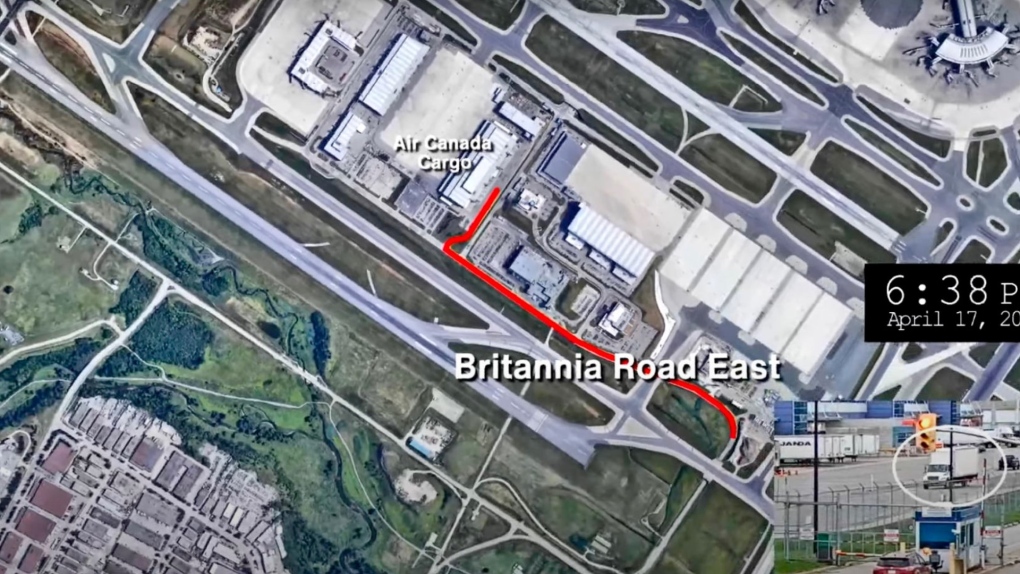Business
2023 could be turning point for office-to-housing conversions: Colliers
|
|
This year could be pivotal for Canada’s office market as developers increasingly eye empty and underused office buildings to help solve the country’s worsening housing shortage, according to Colliers Canada. And one recent conversion in downtown Calgary could serve as a successful playbook.
“2023 could mark a shift in how excess office towers are to be treated,” real estate consulting firm Colliers said in a report.
“Several markets have either announced or have already begun converting certain office towers into residential spaces. This may have a ripple effect on the office construction pipeline if projects are put on pause or even cancelled outright.”
The report, which was released on Mar. 30, said the national office vacancy rate was 13.3 per cent in the first quarter this year, a slight increase from the prior three-month period. It’s also significantly higher than the pre-pandemic first quarter of 2020, when the national office vacancy rate was roughly eight per cent.
Calgary’s conversion ‘experiment’
The challenges and ultimate success of an office-to-housing conversion are on full display in Calgary.
Meet Neoma, an 82-unit affordable housing building that was renovated from an office building in the city’s downtown. It’s owned and operated by affordable housing provider HomeSpace and was renovated by PCL Construction.
HomeSpace bought the building for $4.7 million in 2020 from Artis REIT (AX-UN.TO) and the fast-tracked 12-month renovation of the building costs $30 million. It officially opened in September last year.
“Converting office towers into housing is no easy task,” said Emily Campbell, communications advisor at HomeSpace.
“I would say it was a long, kind of, experimental process to gut the building.”
Canada is staring down a worsening housing crisis while, at the same time, many office towers sit underused thanks to the prevalence of remote work, so it might seem fitting to convert some of these office buildings to help fill the housing need.
Data from commercial real estate firm Avison Young have found that as much as 30 per cent of office towers across Canada, or more than 3,000 properties, are candidates to be converted into housing.
There are roughly three to five different elements that need to align in order for a building to be the perfect prospect for a conversion, Scott Pickles, principal and Canada consulting leader at Avison Young, tells Yahoo Finance Canada. He is also a registered architect.
Whether housing fits with the building owner’s business strategy, financing, location and the work needed to overhaul the building all need to be considered, Pickles says.
The shape of the building and the floor plates, or the structure and layout of an individual floor, also determine if the space can be divided into liveable and desirable apartment units.
Converting electrical and plumbing systems for residential needs can be stymied by whether the elevators are in the right spot, he says.
Older buildings, particularly those built pre-1990, often are better candidates than newer ones, Pickles says, not just because they’re more likely due for upgrades and renovations, but because they tend to have more equity built up and therefore the ability to fund renovations through new debt.
In the case of the Calgary conversion, HomeSpace’s Campbell says the organization looked at “so many” buildings before landing on this one that fits the bill for a residential conversion. Even then, dividing up the floor plan was a “struggle.”
The building sat empty for two years before HomeSpace purchased it.
One of the biggest risks going into the renovation, according to Rob Mitschke, the PCL Construction project manager tasked with the massive overhaul, was understanding where to start.
Everything, from the foundation to the roof, including the original materials used in the construction, structural integrity, building codes, plumbing, electrical, stairwells, elevators (the list goes on), needed to be assessed, he told Yahoo Finance Canada.
“You’re not dealing with an empty field where you dig a hole and build whatever you want. You have to understand your starting point,” he said.
Because of the tight schedule, different phases of the renovation were happening all at once.
“We didn’t have the luxury of completing our demolition, clearing the building out and then starting construction,” Mitschke said.
“So we were simultaneously removing the outside of the building, reinstalling the outside of the building at the same time, floor by floor, gutting the inside of the building, demolition top down and then also starting construction all simultaneously which, given other circumstances, you may give a little space between those items,” he added, jokingly.
The project was funded by the federal and Alberta governments and the City of Calgary, among other public and private donors.
The 10-storey building features a family emergency centre, transitional housing and affordable one, two and three-bedroom units, which are geared towards families.
Monthly rent is 30 per cent below market rates and proportional to residents’ income.
The newest real estate trend?
Mitschke says he has since been approached by “multiple other developers” and is “engaging on a number of [office] buildings” to determine the viability of converting them into housing.
The Calgary office market has a staggering vacancy rate of roughly 28 per cent, according to Colliers data. This is the result of multiple oil price collapses in recent years that ravaged energy companies.
Meanwhile, HomeSpace’s Campbell says residents of the Neoma building are grateful to have a safe and stable place that addresses the root causes of what led some to housing insecurity in the first place.
An added bonus is it brings vibrancy back to downtown Calgary, she says.
“Downtown was starting to feel a little bit dangerous because there’s nobody around. As soon as people clear out of work at six o’clock, Calgary downtown was pretty dead. So, to bring people in creates a sense of safety and security and just brings life back to downtown, which has been struggling,” Campbell said.
Michelle Zadikian is a senior reporter at Yahoo Finance Canada. Follow her on Twitter @m_zadikian.





Business
Pearson airport gold heist: Police announce 9 arrests – CTV News Toronto
Police say one former and one current employee of Air Canada are among the nine suspects that are facing charges in connection with the gold heist at Pearson International Airport last year.
At a news conference Wednesday on the one-year anniversary of the heist, police confirmed that five suspects were arrested and four others are facing charges in connection with the largest gold theft in Canadian history.
Police said the suspects face a total of 19 charges and Canada-wide warrants have been issued for the arrest of three of the suspects who have not yet been apprehended. All of the suspects arrested in connection with the heist have been released on bail, police confirmed in a news release issued Wednesday.
Peel Regional Police Chief Nishan Duraiappah said the heist was “carefully planned” by a “well-organized group of criminals.”
“This story is a sensational one and one which probably, we jokingly say, belongs in a Netflix series,” he said.
Police said 6,600 gold bars were stolen from Air Canada’s cargo facility on the evening of April 17, 2023 by a suspect who arrived at the warehouse in a five-tonne delivery truck.
The gold, along with about $2.5 million in foreign currency, had been shipped to Toronto from Zurich in the hull of an Air Canada plane and was offloaded to an Air Canada cargo facility shortly after the flight landed at Pearson Airport that afternoon.
Police allege that the suspect came into possession of the stolen gold and bank notes after presenting Air Canada personnel with a fraudulent airway bill.
“The airway bill was for a legitimate shipment of seafood that was picked up the day before,” Det.-Sgt. Mike Mavity, the major case manager for the joint investigation, dubbed Project 24K, told reporters on Wednesday.
“This duplicate airway bill was printed off from a printer within Air Canada cargo.”


Brinks Canada, which was hired to provide security and logistics services for the transportation of the shipment, showed up at the facility a few hours later to pick up the items, police said.
According to investigators, when Air Canada employees tried to locate the container, they realized it was missing and quickly launched an internal investigation. Police were notified about the stolen goods shortly before 3 a.m. the following day, Mavity said.
Air Canada launches probe
An exhaustive investigation followed, police said, with officers reviewing video surveillance footage from 225 businesses and residences in an effort to track the path of the truck, which has since been recovered.
Mavity said that last summer, they identified 25-year-old Durante King-McLean as the driver of the truck but were unable to locate him.
In September 2023, Mavity said King-McLean was stopped in rental vehicle by Pennsylvania State Police near Chambersburg, Pennsylvania.
“After a brief foot chase, he was detained and troopers located 65 illegal firearms in the vehicle,” Mavity said Wednesday.
According to Mavity, investigators believe that the stolen gold was melted down and sold and the proceeds were used to purchase illegal guns for a firearms trafficking operation.
He said members of Project 24K have been liaising with the U.S. Alcohol, Tobacco, and Firearms Bureau (ATF) with respect to this aspect of the investigation.
Speaking at the news conference on Wednesday, a representative from the ATF said the law enforcement agency believes the 65 guns seized during the arrest of King-McLean were bound for Canada.
While King-McLean is currently in custody in the United States, he is now wanted on multiple charges in connection with the gold theft.
“We are alleging that some individuals who participated in this gold theft are also involved in aspects of this firearms trafficking,” Mavity added.


Two “debt lists” were found by investigators at separate locations during the investigation, police said.
“A common term in drug trafficking investigations, we believe these lists actually show where the money was distributed when the gold was sold by the suspects,” Mavity said.
He said the names on both lists are “consistent” and police are trying to identify all of those identified.


‘They needed people inside Air Canada’
Police said one current Air Canada employee, identified as 54-year-old Brampton resident Parmpal Sidhu, has been charged with theft over $5,000 and conspiracy to commit an indictable offence. A Canada-wide warrant has been issued 31-year-old Simran Preet Panesar, who police said resigned from his position as a manager at Air Canada back in the summer.
“He has been known to us since early on in the investigation. He actually led a tour for Peel Regional Police before we knew his involvement,” Mavity said Wednesday.
He added that police have an idea where Panesar may be but did not elaborate on a possible location.
Mavity said he believes the suspects needed employees on the inside to carry out the heist.
“Because of their position within Air Canada, in my opinion, yeah they needed people inside Air Canada to facilitate this theft,” he said.

Business
Gas prices expected to rise 14 cents on Thursday
|
|


Drivers are bracing for a double-digit spike at the gas pumps on Thursday, as the price is expected to rise 14 cents at midnight.
Roger McKnight, chief petroleum analyst withEn-Pro International Inc., tells CityNews the price at gas pumps is set to rise to 178.9 cents/litre at local stations. The price as of Wednesday is 164.9 cents/litre.
The last time gas prices were this high was back in August 2022.
McKnight says the spike is due to price increases for wholesale gas and only applies to gasoline. He adds the price for diesel will increase by 0.4 cents.
Earlier this month, the price rose to its highest levels in six months following the implementation of the federal carbon price, also referred to as the carbon tax.
That saw the carbon tax on gasoline go up by 3.3 cents per litre, while diesel increased by 4.1 cents per litre.





Business
Rupture on TC Energy's NGTL gas pipeline sparks wildfire in Alberta – The Globe and Mail
A wildfire burns near Edson, Alta., in this April 16, handout photo.HO/The Canadian Press
A section of TC Energy’s TRP-T NGTL gas pipeline system in Alberta ruptured and caught fire on Tuesday, sparking a wildfire in a remote area, the company said.
“An initial ignition of natural gas at the rupture site is now extinguished. We are working to support Alberta Wildfire in their response to contain a secondary fire,” the company said in a statement on its website.
TC said there were no injuries and it was working closely with first responders in the region.
How fire broke out at the TC gas pipeline near Edson, Alberta
The fire broke out about 40 km (25 miles) northwest of Edson, Alberta, in Yellowhead County. Canadian broadcaster Global News said there was a plume of flames and smoke visible from many kilometres away.
The Canada Energy Regulator (CER) said initial investigations indicated a rupture in a gas pipeline caused the fire, which was under control.
TC Energy said it has isolated and shut down the affected section of the NGTL system, and the remainder of the system is operating normally with no commercial impact.
The CER said it is sending inspectors to the area to monitor and oversee the company’s response and determine the impact of the incident.
NGTL is TC Energy’s natural gas gathering and transportation system that transports gas produced in Western Canadian Sedimentary Basin (WCSB) to markets in Canada and United States.
-



 Sports18 hours ago
Sports18 hours agoTeam Canada’s Olympics looks designed by Lululemon
-



 Politics23 hours ago
Politics23 hours agoPolitical interference in Canada’s pension funds is wrong
-
Business17 hours ago
Firefighters battle wildfire near Edson, Alta., after natural gas line rupture – CBC.ca
-



 Sports23 hours ago
Sports23 hours ago‘BOTTCHER BOMBSHELL:’ Alberta curling foursome set to move forward without skip
-
News19 hours ago
Richard Chevolleau Short Film “Marvelous Marvin” Set to go to Camera
-
News23 hours ago
Freeland tables her fourth federal budget — this time with a tight focus on housing
-



 Investment20 hours ago
Investment20 hours agoStephen Poloz will lead push to boost domestic investment by Canadian pension funds
-



 Tech10 hours ago
Tech10 hours agoiPhone 15 Pro Desperado Mafia model launched at over ₹6.5 lakh- All details about this luxury iPhone from Caviar – HT Tech




